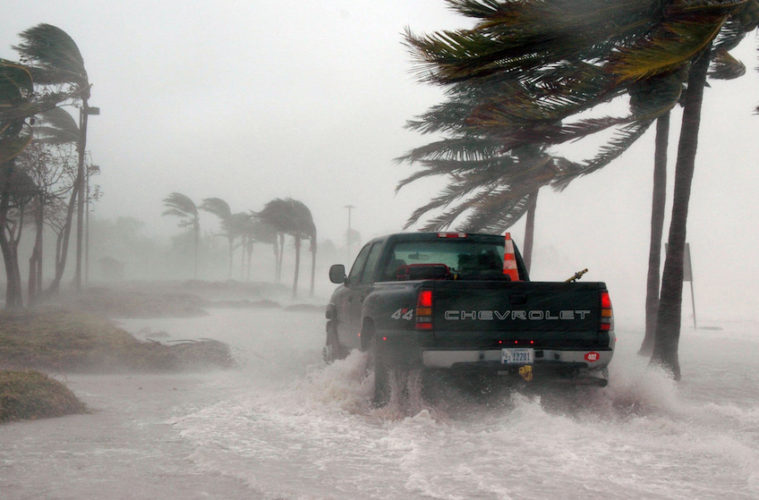Hemp farmers in the Carolinas are drying out after several days of heavy rain from Hurricane Florence, which slammed ashore as a Category 1 storm near Wrightsville Beach, North Carolina on September 14.
Lingering over the Carolinas for days and eventually becoming the wettest tropical cyclone on record for the region, Florence dumped up to 30 inches of rain in some areas and rivers are still rising.
But it appears many hemp farmers have been spared major damage from the storm, and recovery efforts are already underway.
Lucas Snyder, the executive director of the South Carolina Hemp Farmers Association, told HEMP that he is still in the process of getting in contact with growers but so far has received no reports of major damage.
“I heard that in Charleston County they had no problem,” Snyder said. “I haven’t a had a chance to hear back from any of the farmers in the Piedmont region, which are the farms that would have been affected by it, but I haven’t heard anything definitive at this point.”
Coastal Farmer Protects His Crop
David Bulick, the owner of Low Country Nursery and the Charleston Hemp Company in Awendaw, South Carolina, is one of the 20 licensed growers in the state’s fledgling hemp pilot program. After starting plants from seed in a greenhouse, he was getting ready to plant them in the ground early this summer when he had second thoughts. Today, that instinct has payed off.
“Two days before we were supposed to put everything into the field, I just got a gut feeling that I needed to put everything in containers, because that’s my world,” Bulick said.
So, he decided to put the seedlings into pots instead, although he admits he hadn’t considered dealing with the likes of Florence.
“Certainly, a hurricane wasn’t on my radar when we containerized everything,” said Bulick.
But when early forecasts showed his operation was “right in the path of destruction,” Bulick was glad he had followed his instincts. Gathering a crew and two 30-foot horse trailers, early on the morning of Tuesday, September 11, Bulick began moving 15,000 plants, each three to six feet tall. By the time the task was finished Friday evening, Florence was making landfall about 130 miles north. But the hemp crop was now sheltered about 60 miles inland to Ridgeville, with half of the potted plants safely tucked inside a building and the rest sitting on a concrete slab surrounded by protective pine forest.
After Florence had lost much of its force on Sunday, September 16, 90 percent of Bulick’s 50,000 plants of traditional nursery stock left in Awendaw had been blown over by wind, luckily without much damage. But in Ridgeville, the hemp plants were safe from the storm’s wrath.
“At the end of the day, post-storm, not one plant [in Ridgeville] was turned over,” said Bulick. “It was great.”
Inland Areas Protected from Brunt of Storm
The inland location of Lee Ford’s hemp farm in Pickens County, South Carolina — near the borders of both North Carolina and Georgia — protected his crop as well. With the coast more than 250 miles away, Ford and two other hemp farmers nearby weren’t very concerned.
“We really weren’t too worried about it,” Ford said.
“We’re as far away in South Carolina as you can get, so we didn’t blink an eye,” he added.
Ford’s farm did get rain from Florence, but no flooding or damage to his crop.
Ford said that he has been monitoring the situation with some other hemp farmers in South Carolina via social media and has only heard about minor damage from the storm, such as torn greenhouse sheeting.
The inland site of Tony Finch’s farm in North Carolina east of Raleigh also protected his crop from severe weather damage.
“The storm wasn’t as bad here as it could have been, we have definitely had hurricanes come through that have been worse, by far,” he said.
Finch, who farms hemp both independently and in a partnership with Hemp, Inc. said that the crop took some beating from wind and rain and some plants were dying where there is still standing water in fields, but there was no catastrophic damage.
Bruce Perlowin, the CEO of Hemp, Inc., said in a release that the company’s hemp processing infrastructure had also been spared.
“We are grateful that our manufacturing and processing facility was left unscathed, and our thoughts and prayers are with those farmers and residents throughout the state that experienced a more negative impact from the storm’s wrath,” Perlowin said.
With widespread flooding and power outages in North Carolina, efforts by HEMP to contact other farmers there have not yet been successful. HEMP continues to monitor the situation for farmers after Florence and will provide updates if they become available.


